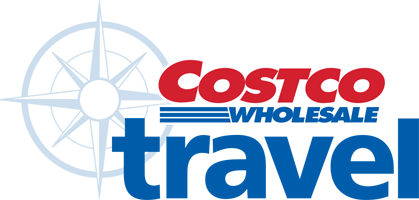
Europe and Mediterranean: Kirkland Signature Cultural Crossing with Andalusia and Azores Cruise
Holland America Line
An epic transatlantic sailing from Rome to Ft. Lauderdale. Pass through the stunning Bonifacio Strait, marvel at Cartagena's 2,000-year-old theater, and visit Ponta Delgada.

Receive exclusive Costco member savings
US $ 50 Shipboard credit (per person, up to two guests)
Executive Member Benefit
Executive Members receive an annual 2% Reward, up to $1,250, on qualified Costco Travel purchases
Digital Costco Shop Card
Member Exclusive: Digital Costco Shop Card with every Holland America Line® sailing†
Sailing Itinerary

Note: Cruise itineraries are subject to change. Please verify ports and times directly with the cruise line.
Overview
Located about 80 kilometers northwest of Rome, the Port of Civitavecchia is the port of Rome and a busy ferry and cargo port serving Italy and southern Europe. Lying on Italy’s eastern shores on the Tyrrhenian Sea, the Port of Civitavecchia has excellent direct connections to Rome. It is an important cruise and ferry port with regular passage to Sardinia, Malta, Sicily, Tunis, and Barcelona. Fishing is of secondary importance to the Port of Civitavecchia. In addition to ocean-going traffic, the Port of Civitavecchia also contains a thermoelectric center and metallurgical works. In 2006, over 51 thousand people called the Port of Civitavecchia home. The Port of Civitavecchia was built on an earlier Etruscan settlement. Emperor Trajan founded the Port of Civitavecchia in the early 2nd Century, calling it Centumcellae. Today, Trajan’s Port is preserved within today’s Port of Civitavecchia. A busy growing town during the late Roman era, the Port of Civitavecchia was attacked by Vandals and then destroyed by the Saracens in 828 AD. Residents escaped to the nearby Allumiere Mountains where Pope Leo IV built a walled town in 854. Eventually, the people returned to Civitavecchia (the name means “old city”). At the end of the 15th Century, the Port of Civitavecchia was under frequent attack by pirates. The naval arsenal was constructed in 1508. Pope Paul III commissioned the building of the keep, which was designed by Donato Bramante and then finished by Michelangelo in 1537, to protect the Port of Civitavecchia from pirate attacks. In 1696, Civitavecchia became a free port under Pope Innocent XII. Because it was Rome’s main port, the French occupied the Port of Civitavecchia in 1849. The Port of Civitavecchia was linked to Rome by the Rome and Civitavecchia Rail Road in 1859. When the Port of Civitavecchia became part of the Kingdom of Italy in 1870, it was one of the Papal State’s most strongly fortified towns when Papal troops welcomed General Nino Bixio on behalf of the Italian unification forces into the Port of Civitavecchia fortress. World War II brought destruction to as much as three-quarters of the Port of Civitavecchia. Reconstruction enlarged the Port of Civitavecchia beyond its pre-war area. The Authority Portuale Civitavecchia (Port of Rome) is responsible for managing and operating the Port of Civitavecchia as well as the ports of Fiumicino and Gaeta. The modern Port of Civitavecchia is at the center of rail, road, and air networks that link it with central Italy and the world. The Port of Civitavecchia can handle about 11 million tons of cargo per year and over 1.5 million passengers. Cargoes include forest products, cereals, iron and steel, chemicals, automobiles, containers, and liquid bulk. In 2007, the Port of Civitavecchia welcomed 856 cruise vessels carrying 1.6 million passengers, and the total number of passengers using ferries and cruise vessels was 3.8 million. In 2007, the Port of Civitavecchia handled a total of 7.7 million tons of cargo. This total included 1.5 million tons of liquid bulk, 1.7 million tons of solid bulk, 4.6 million tons of packages, and 31.1 thousand TEUs of containerized cargo. The Port of Civitavecchia contains 28 berths of a total of 5.6 thousand meters in length alongside depths from 6 to 18 meters. Port properties include five warehouses containing 36 thousand square meters for handling and storing cargo. The intermodal terminal includes seven thousand square meters of storage space and 12.5 thousand square meters for loading/unloading rail cars and parking. The Port of Civitavecchia is one of the busiest ferry ports in the world. Just 80 kilometers northwest of Rome, it is the main tourist destination for people traveling to the Eternal City. It is also a central port for ferries carrying passengers to more local destinations. The ferry terminal offers a complete line of amenities. Different ferry companies offer services to various destinations. Moby Lines handles crossings to Olbia, Sardinia. Corsica Sardinia Ferries runs services to Golfo Aranci. Grimaldi Ferries carries passengers to Barcelona and Tunis, and Grand Navi Veloci operates a route to Tunis. Ferrovie dello Stato operates a combined rail-ferry service to Golfo Aranci.
Overview
The Strait of Bonifacio is the strait between Corsica and Sardinia, named after the Corsican town Bonifacio. It is 11 km wide and divides the Tyrrhenian Sea from the western Mediterranean Sea.
Overview
The capital of the region with a population of 168,000, Cartegena was founded, as its name suggests, by the Carthaginians in 227 BC and it became Hannibal’s capital city on the Iberian Peninsula. Today it is a modern, industrial city although relics of the past are still highly visible. The narrow streets of the old town were built around the ruined 13th-century cathedral. There are several sites of historical interest including the remains of the Roman road, an old Roman theatre and the Literna (an ancient lighthouse of Moorish origins). Cartagena’s ancient seaport and naval dockyard is where the first submarine was built in 1900 and where submarines are still built today. The port consists of a deep bay with a natural harbour, hence the town’s historical importance. Cartagena has a large shopping centre, plenty of supermarkets and other amenities you would expect to find in a large town including a hospital, schools and sports facilities. The town is the major service centre for the Costa Calida urbanizations that continue to develop around it.Cartegena is 30 minutes drive from Murcia via the N301San Javier airport is 15km from Cartagena.The excellent golf courses at La Manga, which has 3 18-hole courses of international standard, are 20km away.
Overview
Málaga is a port city on southern Spain’s Costa del Sol, known for its high-rise hotels and resorts jutting up from yellow-sand beaches. Looming over that modern skyline are the city’s 2 massive hilltop citadels, the Alcazaba and ruined Gibralfaro, remnants of Moorish rule. The city's soaring Renaissance cathedral is nicknamed La Manquita ("one-armed lady") because one of its towers was curiously left unbuilt.
Overview
Gibraltar is a British Overseas Territory and headland, on Spain's south coast. It’s dominated by the Rock of Gibraltar, a 426m-high limestone ridge. First settled by the Moors in the Middle Ages and later ruled by Spain, the outpost was ceded to the British in 1713. Layers of fortifications include the remains of a 14th-century Moorish Castle and the 18th-century Great Siege Tunnels, which were expanded in WWII.
Overview
Ponta Delgada, capital of the Azores, is situated on the largest island, Sao Miguel, of the Azores. It has marvelous churches, some with fabulous Baroque interiors. Also palaces from the 17th and 18th centuries. Other places worth visiting are the Lagoa do Fogo and the village of Ribeira Grande, which has important architectural features. Set within the confines of a wide inlet, Ponta Delgada is the tourist heart of São Miguel. Museums and monuments abound, and historic streets connect hotels, restaurants, and shops. A marinaharborss sailboats from Europe and America. And for those who enjoy entertainment after hours, the night brings with it a touch of animation.
Overview
Fort Lauderdale is a city on Florida's southeastern coast, known for its beaches and boating canals. The Strip is a promenade running along oceanside highway A1A. It's lined with upscale outdoor restaurants, bars, boutiques, and luxury hotels. Other attractions include the International Swimming Hall of Fame, with pools and a museum of memorabilia, and Hugh Taylor Birch State Park, featuring trails and a lagoon.
Onboard the Nieuw Statendam
Nieuw Statendam
Year Built: 2017
Honoring Holland America Line's past while keeping its eyes on the future, Nieuw Statendam is the sixth ship in Holland America Line’s history to bear the name Statendam and features several of the innovative venues that were introduced on her sister ship, the Koningsdam.
Activities & Services (included in cruise)

Casino
- Casino
- Fitness Center
- Culinary Arts Center
- Pool - Outdoor
- Pool - Indoor/Covered
- Sports Facilities
- Whirlpool/Jacuzzi
- Bars/Lounges
- Organized Age Specific Activities
- Teen Programs
- Concierge Desk
- Elevators
- Safe Deposit Boxes
Activities & Services (available for an extra fee)

Greenhouse Spa
- Full-Service Spa
- Spa Services/Massage
- Dry Cleaning/ Laundry Service
- Duty-Free Shops/Boutiques
- Infirmary/Medical Center

The Dining Room
Main Dining
The Dining Room: For breakfast, lunch or an unforgettable five-course dinner, the elegant main Dining Room is your destination for sophisticated dining, with menu selections from classic favorites to vegetarian options, to dishes inspired by the regions you’ll visit. Menus by Holland America Line's Culinary Council® of world-renowned chefs.

Pinnacle Grill
Specialty Dining
Pinnacle Grill: Enjoy dishes inspired by America’s Pacific Northwest, such as king salmon from Alaska and choice, responsibly raised beef from Washington State’s Double R Ranch. Complement your meal with a selection of boutique wines from the Pacific Northwest and other celebrated vineyards from around the world. This restaurant is available for an additional cost.
Canaletto: This authentic Italian restaurant offers a menu that celebrates spartire (Italian for "sharing"). Try Braised Chicken Cacciatore "al Forno," Branzino ai Ferri or a classic Italian pasta: spaghetti pomodoro or garlic shrimp-infused ravioli, perhaps. Buon appetito! This restaurant is available for an additional cost.
Tamarind: Tamarind delights diners with exotic menus evoking the culinary traditions of Southeast Asia, China and Japan. Recently noted by Condé Nast Traveler for its “cuisine that rivals the top restaurants on land,” Tamarind is located on the uppermost deck, providing stunning panoramic views. Lunch includes tantalizing items such as steamed dim sum and spicy crab. Exotic dinner menus created by Master Chef Rudi Sodamin feature dishes honoring the elements of water, wood, fire and earth. This restaurant is available for an additional cost.

Room Service
Casual Dining
Lido Market: Lido Market provides a fresh, new approach to casual dining for breakfast, lunch or dinner, with a panoramic view of the sea. A modern marketplace with different themed stations, the Lido offers a curated selection of delicious options to grab on the go or to have quickly made to order.
Dive-In: Dive in to a grilled burger on brioche or a Nathan’s Famous gourmet hot dog. For alfresco dining by the pool, Dive-In has it all, including lighter fare like the grilled chicken breast sandwich and vegetarian-friendly portabella mushroom stack.
New York Pizza: Crisp Italian salads and personal pan pizzas made with a thin crust and a savory sauce are served up poolside.
Explorations Café: A comfortable, coffeehouse environment offering espresso drinks and pastries. This restaurant is available for an additional cost.
Grand Dutch Café: Inspired by blue and white Delftware, the Grand Dutch Café is the place to enjoy a fine pale lager or favorite coffee beverage with a traditional Dutch snack. This restaurant is available for an additional cost.
Room Service: Complimentary 24-hour dining in the comfort of your stateroom.
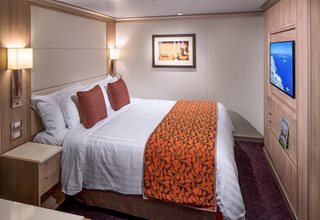
Category: IQ
Amenities- Daily housekeeping
- Complimentary 24-hour room service
- Elemis Aromapure soap, lotion, shampoo
- Luxurious bathrobes
- Generous storage
- Fresh fruit upon request
- Safe
- Ice service
- Shoeshine
- TV with On Demand movies, programming

Category: I
Amenities- Daily housekeeping
- Complimentary 24-hour room service
- Elemis Aromapure soap, lotion, shampoo
- Luxurious bathrobes
- Generous storage
- Fresh fruit upon request
- Safe
- Ice service
- Shoeshine
- TV with On Demand movies, programming

Category: J
Amenities- Daily housekeeping
- Complimentary 24-hour room service
- Elemis Aromapure soap, lotion, shampoo
- Luxurious bathrobes
- Generous storage
- Fresh fruit upon request
- Safe
- Ice service
- Shoeshine
- TV with On Demand movies, programming

Category: K
Amenities- Daily housekeeping
- Complimentary 24-hour room service
- Elemis Aromapure soap, lotion, shampoo
- Luxurious bathrobes
- Generous storage
- Fresh fruit upon request
- Safe
- Ice service
- Shoeshine
- TV with On Demand movies, programming

Category: L
Amenities- Daily housekeeping
- Complimentary 24-hour room service
- Elemis Aromapure soap, lotion, shampoo
- Luxurious bathrobes
- Generous storage
- Fresh fruit upon request
- Safe
- Ice service
- Shoeshine
- TV with On Demand movies, programming

Category: N
Amenities- Daily housekeeping
- Complimentary 24-hour room service
- Elemis Aromapure soap, lotion, shampoo
- Luxurious bathrobes
- Generous storage
- Fresh fruit upon request
- Safe
- Ice service
- Shoeshine
- TV with On Demand movies, programming
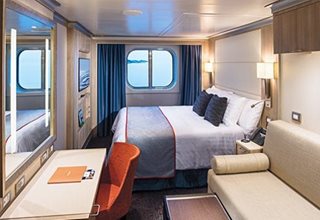
Category: FA
Amenities- Daily housekeeping
- Complimentary 24-hour room service
- Elemis Aromapure soap, lotion, shampoo
- Luxurious bathrobes
- Hair dryers, makeup mirrors
- Fresh fruit upon request
- Safe
- Ice service
- Shoeshine
- TV with On Demand movies, programming

Category: FB
Amenities- Daily housekeeping
- Complimentary 24-hour room service
- Elemis Aromapure soap, lotion, shampoo
- Luxurious bathrobes
- Hair dryers, makeup mirrors
- Fresh fruit upon request
- Safe
- Ice service
- Shoeshine
- TV with On Demand movies, programming
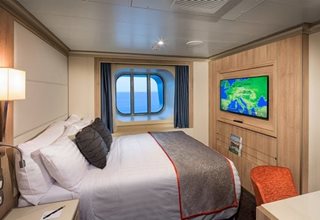
Category: CQ
Amenities- Daily housekeeping
- Complimentary 24-hour room service
- Elemis Aromapure soap, lotion, shampoo
- Luxurious bathrobes
- Hair dryers, makeup mirrors
- Fresh fruit upon request
- Safe
- Ice service
- Shoeshine
- TV with On Demand movies, programming
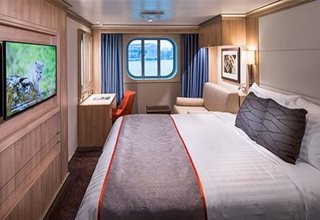
Category: C
Amenities- Daily housekeeping
- Complimentary 24-hour room service
- Elemis Aromapure soap, lotion, shampoo
- Luxurious bathrobes
- Hair dryers, makeup mirrors
- Fresh fruit upon request
- Safe
- Ice service
- Shoeshine
- TV with On Demand movies, programming

Category: D
Amenities- Daily housekeeping
- Complimentary 24-hour room service
- Elemis Aromapure soap, lotion, shampoo
- Luxurious bathrobes
- Hair dryers, makeup mirrors
- Fresh fruit upon request
- Safe
- Ice service
- Shoeshine
- TV with On Demand movies, programming

Category: E
Amenities- Daily housekeeping
- Complimentary 24-hour room service
- Elemis Aromapure soap, lotion, shampoo
- Luxurious bathrobes
- Hair dryers, makeup mirrors
- Fresh fruit upon request
- Safe
- Ice service
- Shoeshine
- TV with On Demand movies, programming

Category: F
Amenities- Daily housekeeping
- Complimentary 24-hour room service
- Elemis Aromapure soap, lotion, shampoo
- Luxurious bathrobes
- Hair dryers, makeup mirrors
- Fresh fruit upon request
- Safe
- Ice service
- Shoeshine
- TV with On Demand movies, programming
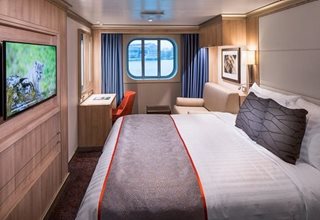
Category: OO
Amenities- Daily housekeeping
- Complimentary 24-hour room service
- Elemis Aromapure soap, lotion, shampoo
- Luxurious bathrobes
- Hair dryers, makeup mirrors
- Fresh fruit upon request
- Safe
- Ice service
- Shoeshine
- TV with On Demand movies, programming
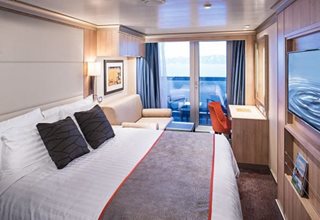
Category: VQ
Amenities- Daily housekeeping
- Complimentary 24-hour room service
- Elemis Aromapure soap, lotion, shampoo
- Luxurious bathrobes
- Hair dryers, makeup mirrors
- Fresh fruit upon request
- Safe
- Ice service
- Shoeshine
- TV with On Demand movies, programming

Category: VS
Amenities- Daily housekeeping
- Complimentary 24-hour room service
- Elemis Aromapure soap, lotion, shampoo
- Luxurious bathrobes
- Hair dryers, makeup mirrors
- Fresh fruit upon request
- Safe
- Ice service
- Shoeshine
- TV with On Demand movies, programming

Category: V
Amenities- Daily housekeeping
- Complimentary 24-hour room service
- Elemis Aromapure soap, lotion, shampoo
- Luxurious bathrobes
- Hair dryers, makeup mirrors
- Fresh fruit upon request
- Safe
- Ice service
- Shoeshine
- TV with On Demand movies, programming

Category: VA
Amenities- Daily housekeeping
- Complimentary 24-hour room service
- Elemis Aromapure soap, lotion, shampoo
- Luxurious bathrobes
- Hair dryers, makeup mirrors
- Fresh fruit upon request
- Safe
- Ice service
- Shoeshine
- TV with On Demand movies, programming

Category: VB
Amenities- Daily housekeeping
- Complimentary 24-hour room service
- Elemis Aromapure soap, lotion, shampoo
- Luxurious bathrobes
- Hair dryers, makeup mirrors
- Fresh fruit upon request
- Safe
- Ice service
- Shoeshine
- TV with On Demand movies, programming

Category: VC
Amenities- Daily housekeeping
- Complimentary 24-hour room service
- Elemis Aromapure soap, lotion, shampoo
- Luxurious bathrobes
- Hair dryers, makeup mirrors
- Fresh fruit upon request
- Safe
- Ice service
- Shoeshine
- TV with On Demand movies, programming

Category: VD
Amenities- Daily housekeeping
- Complimentary 24-hour room service
- Elemis Aromapure soap, lotion, shampoo
- Luxurious bathrobes
- Hair dryers, makeup mirrors
- Fresh fruit upon request
- Safe
- Ice service
- Shoeshine
- TV with On Demand movies, programming

Category: VE
Amenities- Daily housekeeping
- Complimentary 24-hour room service
- Elemis Aromapure soap, lotion, shampoo
- Luxurious bathrobes
- Hair dryers, makeup mirrors
- Fresh fruit upon request
- Safe
- Ice service
- Shoeshine
- TV with On Demand movies, programming

Category: VF
Amenities- Daily housekeeping
- Complimentary 24-hour room service
- Elemis Aromapure soap, lotion, shampoo
- Luxurious bathrobes
- Hair dryers, makeup mirrors
- Fresh fruit upon request
- Safe
- Ice service
- Shoeshine
- TV with On Demand movies, programming

Category: VH
Amenities- Daily housekeeping
- Complimentary 24-hour room service
- Elemis Aromapure soap, lotion, shampoo
- Luxurious bathrobes
- Hair dryers, makeup mirrors
- Fresh fruit upon request
- Safe
- Ice service
- Shoeshine
- TV with On Demand movies, programming
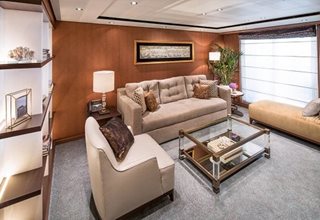
Category: PS
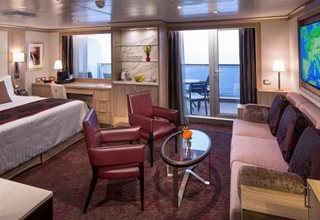
Category: SQ
Amenities- Daily housekeeping
- Complimentary 24-hour room service
- Elemis Aromapure soap, lotion, shampoo
- Premium bathrobes, slippers
- Hair dryers, makeup mirrors
- Fresh fruit upon request
- Safe
- Ice service
- Shoeshine
- TV with On Demand movies, programming
- Fresh flowers
- One-Touch concierge service
- Whirlpool bath (suite dependent)
- In-suite coffee, espresso
- Complimentary laundry
- Pre-dinner hors d'oeuvres served in suite
- Welcome glass of sparkling wine
- Priority boarding for tender ports, priority dining/seating requests, special disembarkation service
- High tea in suite on request
- Binoculars
- Exclusive tote bag

Category: SA
Amenities- Daily housekeeping
- Complimentary 24-hour room service
- Elemis Aromapure soap, lotion, shampoo
- Premium bathrobes, slippers
- Hair dryers, makeup mirrors
- Fresh fruit upon request
- Safe
- Ice service
- Shoeshine
- TV with On Demand movies, programming
- Fresh flowers
- One-Touch concierge service
- Whirlpool bath (suite dependent)
- In-suite coffee, espresso
- Complimentary laundry
- Pre-dinner hors d'oeuvres served in suite
- Welcome glass of sparkling wine
- Priority boarding for tender ports, priority dining/seating requests, special disembarkation service
- High tea in suite on request
- Binoculars
- Exclusive tote bag

Category: SB
Amenities- Daily housekeeping
- Complimentary 24-hour room service
- Elemis Aromapure soap, lotion, shampoo
- Premium bathrobes, slippers
- Hair dryers, makeup mirrors
- Fresh fruit upon request
- Safe
- Ice service
- Shoeshine
- TV with On Demand movies, programming
- Fresh flowers
- One-Touch concierge service
- Whirlpool bath (suite dependent)
- In-suite coffee, espresso
- Complimentary laundry
- Pre-dinner hors d'oeuvres served in suite
- Welcome glass of sparkling wine
- Priority boarding for tender ports, priority dining/seating requests, special disembarkation service
- High tea in suite on request
- Binoculars
- Exclusive tote bag

Category: SC
Amenities- Daily housekeeping
- Complimentary 24-hour room service
- Elemis Aromapure soap, lotion, shampoo
- Premium bathrobes, slippers
- Hair dryers, makeup mirrors
- Fresh fruit upon request
- Safe
- Ice service
- Shoeshine
- TV with On Demand movies, programming
- Fresh flowers
- One-Touch concierge service
- Whirlpool bath (suite dependent)
- In-suite coffee, espresso
- Complimentary laundry
- Pre-dinner hors d'oeuvres served in suite
- Welcome glass of sparkling wine
- Priority boarding for tender ports, priority dining/seating requests, special disembarkation service
- High tea in suite on request
- Binoculars
- Exclusive tote bag
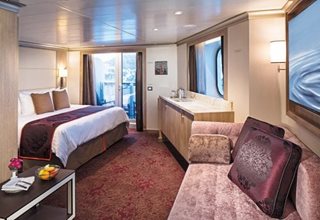
Category: SS
Amenities- Daily housekeeping
- Complimentary 24-hour room service
- Elemis Aromapure soap, lotion, shampoo
- Luxurious bathrobes
- Hair dryers, makeup mirrors
- Generous storage
- Fresh fruit upon request
- Safe
- Ice service
- Shoeshine
- TV with On Demand movies, programming
- Binoculars

Category: SY
Amenities- Daily housekeeping
- Complimentary 24-hour room service
- Elemis Aromapure soap, lotion, shampoo
- Luxurious bathrobes
- Hair dryers, makeup mirrors
- Generous storage
- Fresh fruit upon request
- Safe
- Ice service
- Shoeshine
- TV with On Demand movies, programming
- Binoculars
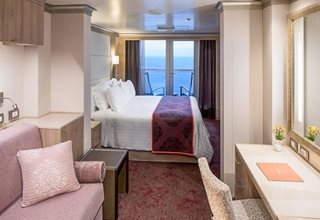
Category: AS
Amenities- Daily housekeeping
- Complimentary 24-hour room service
- Elemis Aromapure soap, lotion, shampoo
- Luxurious bathrobes
- Hair dryers, makeup mirrors
- Generous storage
- Fresh fruit upon request
- Safe
- Ice service
- Shoeshine
- TV with On Demand movies, programming
- Binoculars

Category: A
Amenities- Daily housekeeping
- Complimentary 24-hour room service
- Elemis Aromapure soap, lotion, shampoo
- Luxurious bathrobes
- Hair dryers, makeup mirrors
- Generous storage
- Fresh fruit upon request
- Safe
- Ice service
- Shoeshine
- TV with On Demand movies, programming
- Binoculars

Category: B
Amenities- Daily housekeeping
- Complimentary 24-hour room service
- Elemis Aromapure soap, lotion, shampoo
- Luxurious bathrobes
- Hair dryers, makeup mirrors
- Generous storage
- Fresh fruit upon request
- Safe
- Ice service
- Shoeshine
- TV with On Demand movies, programming
- Binoculars

Category: BC
Amenities- Daily housekeeping
- Complimentary 24-hour room service
- Elemis Aromapure soap, lotion, shampoo
- Luxurious bathrobes
- Hair dryers, makeup mirrors
- Generous storage
- Fresh fruit upon request
- Safe
- Ice service
- Shoeshine
- TV with On Demand movies, programming
- Binoculars
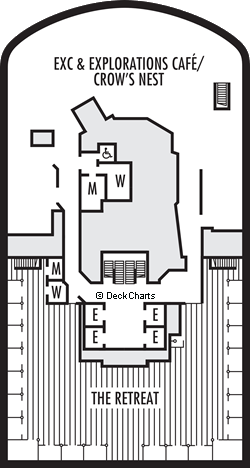
| Symbol | Description |
|---|---|
 | Quad (2 lower beds, 1 sofa bed, 1 upper) |
 | Triple (2 lower beds, 1 upper) |
 | Triple (2 lower beds, 1 sofa bed) |
 | Double (2 lower beds convertible to 1 king-size bed, no Murphy bed) |
 | Partially obstructed view |
 | Connecting rooms |
 | Floor-to-ceiling windows |
 | Shower only |
 | Uncovered verandah |
 | Staterooms have solid steel verandah railings instead of clear-view Plexiglas railings |
 | Fully accessible, roll-in shower only |
 | Ambulatory accessible, shower only with small step, steip into bathroom, standard interior and exterior door size |
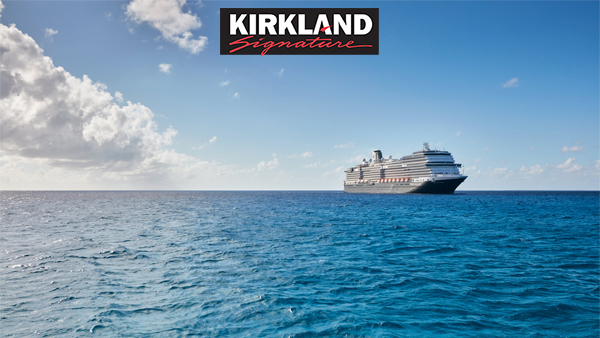
- Ship Name: Nieuw Statendam
- Year Built: 2017
- Year Entered Present Fleet: 2018
- Ship Class: Pinnacle
- Maximum Capacity: 2,666
- Number of Passenger Decks: 13
- Number of Crew: 1,036
- Officers' Nationality: International
- Tonnage (GRT): 99,500
- Country of Registry: Netherlands
- Crew/Hotel Staff Nationality: International
Costco Member Reviews

Available Dates & Prices
Terms & Conditions
*Price shown is per person based on double occupancy, is valid for select stateroom categories only, and does not include the Kirkland Signature Included Extras. The Kirkland Signature rate will be shown in the Rates section on the Stateroom Category page during booking.
♦Included Extras are for first and second passengers only unless noted otherwise. Shipboard credit has no cash value, is nontransferable, and is not redeemable for cash.
†One Digital Costco Shop Card per room/stateroom, per stay. The exact amount of the Digital Costco Shop Card will be calculated during the booking process. The Digital Costco Shop Card promotion is nontransferable and may not be combined with any other promotion. A Digital Costco Shop Card will arrive by email approximately 10 days after the start of your cruise. Click on the Terms & Conditions link below for additional information.
Ship's registry: The Netherlands
Digital Costco Shop Card
This booking includes a Digital Costco Shop Card which will arrive by email one to two weeks after you return from your vacation. The Digital Costco Shop Card is a convenient payment option in our warehouses and on Costco.ca.

